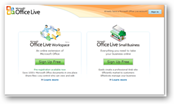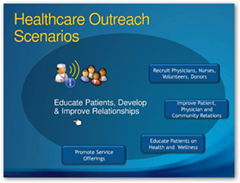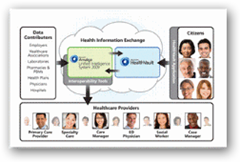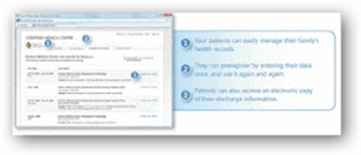I recently had the opportunity to spend some time discussing with Chris Sullivan, National Director, Health Provider Solutions, Microsoft Health & Life Sciences, the company’s support and solutions for small physician practices and hospitals. Electronic medical records and Health IT is foremost on everyone’s agenda today and  Chris provided information on where Microsoft focuses and the many solutions they provide and support.
Chris provided information on where Microsoft focuses and the many solutions they provide and support.
Last year I talked with Michael Naimoli Industry Solutions Director for Microsoft’s U.S. Health & Life Sciences Group, and today we are looking at one of Chris’ areas of responsibility with both hospitals and physician practices relative to product support and offerings from Microsoft. Chris has been in his current position for 4 years and has 15 years with Microsoft all together which tells me there’s a lot of information available to share.
(Over the past 3 years I have several articles that reference some of the technologies Chris and I spoke about today and you can do a simple search to locate some past articles.)
I asked Chris what types of solutions are available for the small practices and what methodologies and services does Microsoft promote?
There are a number of areas where Microsoft can work with small healthcare practices, and one area in particular that clinicians are particularly familiar with is Microsoft Office just simply due to the fact that it has existed for many years as one of our flagship products. Even if a physician has an electronic medical records system in place, chances are that they’re using additional software from Microsoft Office for either support or to complement the existing EMR software.
Microsoft Office has been around for a number of years and the physician’s familiarity with both Outlook and Word makes for a good starting ground. In addition, many electronic medical record vendors store all their data in Microsoft SQL server, so there’s a good chance that when the practice purchased an electronic medical records system, they may have already invested in software that is using Microsoft technology.
Microsoft Small Business Server is another great starting place for a small practice as it offers Outlook Exchange and other software to connect to back end storage data on a network. It is less expensive than purchasing Server 2008 and has some built-in efficiencies that help make configuring and setting up a bit easier too.
If a provider office was just looking to purchase a medical records system, would they need a server within the office network?
Great question, as depending on what configurations the practice may be looking at today, they might benefit from web-based services in the “cloud.” In other words, using the web to store records. As you read in the news today, moving to the “cloud” is becoming a real focus with Web services and storing information in data centers. On the other hand, practices are looking for “hybrid” solutions. Microsoft Office is exactly that  with Office Live offering several features that would be desirable for a small practice. With Office Live Small Business, it’s fairly simple to get started with email, a small SharePoint Server and secured sharing of documents. This is a solution for those small practices who do not want to maintain a server in the office. It provides a website application that is easy enough to set up and maintain, and a control panel manages permissions for the users. If you have a current web page domain, you can move it on over.
with Office Live offering several features that would be desirable for a small practice. With Office Live Small Business, it’s fairly simple to get started with email, a small SharePoint Server and secured sharing of documents. This is a solution for those small practices who do not want to maintain a server in the office. It provides a website application that is easy enough to set up and maintain, and a control panel manages permissions for the users. If you have a current web page domain, you can move it on over.
In addition to the web services of Office Live, mail and documents also connect easily with desktop Office installations, so this offers the best of both worlds with users having the option of access via the web or through the familiar Microsoft Office desktop software. This is a great value and additional storage space is available by monthly subscription for SharePoint services and a few additional web-based application services.
One item we also emphasize with physicians today is the importance of having a “web presence,” not only as an information showcase, but how to make that website work for the doctors and the practice. Office Live offers simplicity here with the ability to get set up and running quickly without the need for extensive programming and a lot of IT support.
We are really focused on reaching out to involve the practice, from the physicians to the patients, in all aspects whether record keeping or making communication simple and effective.
(I use Office Live myself and have recommended it to small practices.)
There are many small practices in the US and those needing help and assistance, how does Microsoft reach to all of them?
That is a good question and what we do at Microsoft is use a network of “Partners” that develop and market our products. Our Partner Network is very active and through this network small practices are able to learn and purchase products that they can use with Microsoft technologies. For instance, in ![]() the electronic medical records area we have several that work with us. One particular EHR vendor that comes to mind is GloStream, and the reason for the mention here is their product has a very familiar interface. GloStream has used the Microsoft Office platform to bring a sense of familiarity to their records system. I feel that this is a key factor to adaptation as their model presents a smaller learning curve due to the fact that many physicians are already familiar with Microsoft Office. Recently in the news GloStream also announced their integration with Microsoft Office 2010.
the electronic medical records area we have several that work with us. One particular EHR vendor that comes to mind is GloStream, and the reason for the mention here is their product has a very familiar interface. GloStream has used the Microsoft Office platform to bring a sense of familiarity to their records system. I feel that this is a key factor to adaptation as their model presents a smaller learning curve due to the fact that many physicians are already familiar with Microsoft Office. Recently in the news GloStream also announced their integration with Microsoft Office 2010.
In addition to our current partners, Microsoft also has a site called BizSpark whereby software companies can get started and connected with investors to fund and continue development of products. GloStream EHR was accepted in 2009 to the Microsoft Startup Accelerator program. There have been many others in healthcare featured here and they too have had the ability to get their solutions to market.
(Back in July of 2009 I did a post relative to GloStream and Microsoft Office and you can view more information to get an idea as to how it works.)
Microsoft BizSpark – Free help, Software, Venture Capitalists and Angel Connections ![]()
With reference to electronic medical record vendors, are there other partners who take advantage of Microsoft Office?
There certainly are many additional Partners who use Microsoft Word as an enhancement to their medical records programs, companies like e-Clinical Works, NextGen, and E-MDs are a few vendors that come to mind. These partners have been around for quite a while and use Word templates and documents to enhance their offerings. Some Partners also integrate and/or create connections with Outlook to enable a familiar process for sending and receiving email within their software. Outlook has been a business/enterprise standard for years.
CRM (customer relations management) software is also playing an important role today with healthcare. Microsoft Dynamics is our own CRM software and Microsoft has a version that is specific for use in healthcare. Once more we leverage the strength of our Partners to help create CRM solutions for both small providers and larger institutions such as hospitals. CRM adds the finishing touch to follow up and email communications in healthcare with added automation and thus less time spent by staff members trying to manually keep up with today’s demands with effective patient communication.
In meeting with and talking to small practices, we like to emphasize the importance of understanding the need to upgrade or buy new IT resources when needed, as Health IT is continuing to evolve today at a rapid pace. One of our Partners put together a slide show which can be viewed that describes the use and benefits of CRM in healthcare today. In addition to our own CRM software there are a number of other CRM software companies that also use Microsoft Office as either a platform or an embedded solution. Again, these products make the transition and learning curve a lot easier for physicians as they have likely used and are familiar with the Microsoft interface either through use at the office or at home, too.
Now that we have talked a bit about some of the offerings and benefits for the small practice, does your division also communicate and work with connecting hospitals as well? I know Microsoft has their own healthcare products such as Amalga for hospitals and HealthVault for the consumer PHR, so can you tell me how your own in-house products fit into the scenario?
I know you cover a lot of this information in your blog, being a regular reader here, and yes this is another full focus area for our division. Actually, we always talk about healthcare somewhat being behind in many areas of IT, but I feel this area is where healthcare is actually ahead of the pack in many respects. Hospitals are taking an active role in promoting physician connectivity and sharing records to provide a more comprehensive experience for everyone across the ecosystem, including the physician practice and the patient. I remember you covered this quite a bit through your conversation last year with Steve Shihadeh, VP Microsoft Health Solutions Group.
We see hospitals as key stake holders in the business of Health IT. One example is St. Josephs Hospital, who was an early adaptor of the Microsoft Amalga UIS platform and data services. They are working with Allscripts to help subsidize the cost of electronic medical records for the physicians who are on staff and making the purchasing process a little less expensive for their doctors. ![image_thumb21[4] image_thumb21[4]](http://lh6.ggpht.com/_v3zjJigoAPE/TCTxTY-clHI/AAAAAAAAfJw/gZB1p5J7lYc/image_thumb2143.png?imgmax=800)
For more insight on aggregation and Microsoft Amalga Unified Intelligence System we have compiled some information that helps explain the entire process of connecting hospitals, doctors and patients. With aggregating patient information between hospitals and having it available immediately when the patient needs treatment, there’s no comparison to old paper methodologies when it comes to providing better care. The information is readily available at the emergency rooms and in other areas of the hospitals. When you stop and think how long it would take for healthcare facilities to request and receive faxed information, this is a long and tedious process and it can take time away from staff members who have other areas of responsibility to manage. As for savings realized with Health IT, this is one of the areas although an exact dollar sign is hard to assign as every situation is different.
Getting back to utilizing Microsoft Office services and platforms, today we published a case study on the use of Business Intelligence through leveraging several of our technologies to include SharePoint Server, SQL Server 2008, Excel, and Office 2010 in the Boston area. CareGroup Healthcare, which includes Harvard teaching hospital Beth Israel Deaconess-Harvard Medical, is a long time user of SQL server and is now realizing some great results with using Microsoft SQL Server PowerPivot for Microsoft Excel.
“With SharePoint Server 2010, the CareGroup IT staff will be able to track usage of reports, enforce security policies for sensitive information, conduct audits, and monitor network performance when intranet-based analysis is refreshed with new information from CareGroup databases.”
So far we have talked about small practices and hospitals, so how does all the information help the patient, as they are the intricate part of the entire solution, in other words nothing else gets set in motion without having a patient, correct?
My mother is 85 years old and is able to reference and add information to her HealthVault account and thus I like to use her as a reference as far as the consumer side as if she can work with it, that leaves a lot of room for more to participate. As her daughter I am glad that we are able to store her information as I have it available to me without having to dig through a box of paper files, and the fact that she lives in a different state would make this almost impossible for me. How does a hospital connect and work with information flow for the patients?
 You are right with involving the patient – whether it’s coming from the physicians practice or the hospital – and this is definitely another focal point for our division. HealthVault as the “platform” used to facilitate and make information available to the most important part of this chain of information, the patient. I know you have several articles on the blog here about the consumer side of HealthVault. HealthVault Community Connect uses SharePoint Server and can be a standalone or combined with Amalga Unified Intelligence software. As a standalone product, many smaller hospitals can benefit.
You are right with involving the patient – whether it’s coming from the physicians practice or the hospital – and this is definitely another focal point for our division. HealthVault as the “platform” used to facilitate and make information available to the most important part of this chain of information, the patient. I know you have several articles on the blog here about the consumer side of HealthVault. HealthVault Community Connect uses SharePoint Server and can be a standalone or combined with Amalga Unified Intelligence software. As a standalone product, many smaller hospitals can benefit.
Microsoft had a pilot program with NewYork–Presbyterian, myNYP.org, that began a little over a year ago and is a health portal built upon Microsoft Amalga UIS and HealthVault. One of the most outspoken and well known users at the hospital, Dr. Oz has added his recent comments with working with personal health records and their value.
“The paper-based system is sort of ‘Here, and good luck,’ ” Dr. Oz said. “It’s cumbersome and dangerous.” The online personal health record makes efficient communication and continuity of care far easier, Dr. Oz said. It can be accessed by the patient and, with permission, relatives and a patient’s personal physician.”
Our vision is to bring people across the healthcare ecosystem together with the information they need to make intelligent healthcare decisions, while at the same time provide a simple and familiar face to the end users. We all know how long it takes these days to train and start from scratch with software we have never used or seen before.
Thank you Chris for your time and information. We had a word packed line of discussion, as almost everyone knows I do my fair share, and I hope to have captured summary of helpful information today!
(One item as a footnote here with familiarity, I agree with using Office and the time it saves with moving adaptation along as I did the same thing years ago when writing a medical records system, I tried to leverage Office as much as I could and more specifically Word as the MDs working me would clearly ask or suggest “can you make it work and look like Word”, questions I received from the front line.)
Related Posts:
Microsoft Research: Research & Programs for Healthcare
Genomics and Silverlight from Microsoft working together for Great Visual Enhancement– BioMashUps
Microsoft Introduces Groundbreaking Technology – Amalga Life Sciences Software
Microsoft and the National Science Foundation Enabling Research in the Cloud (Azure)
Microsoft Acquires Sentillion – Single Sign On To Work With Amalga and More…



